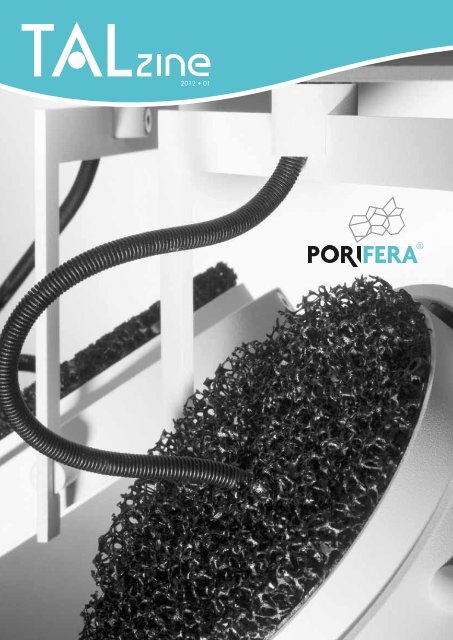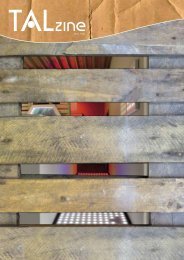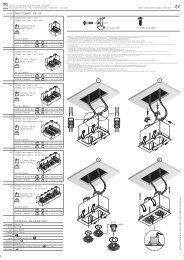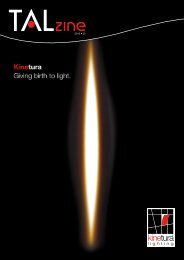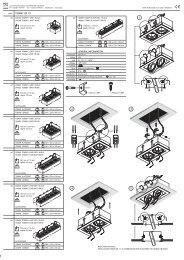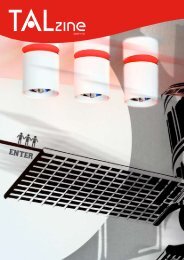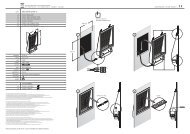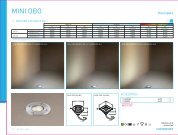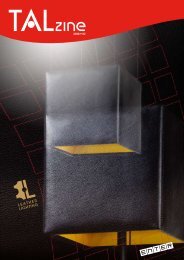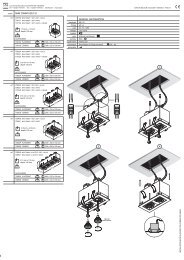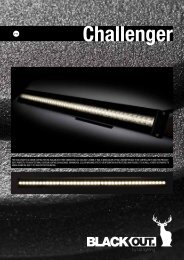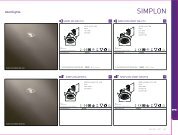Create successful ePaper yourself
Turn your PDF publications into a flip-book with our unique Google optimized e-Paper software.
2012 • 01
index<br />
Porifera uk - nl - fr - du - es . . . . . . . . . . . . . . . . . . . . . . . . . . . .P03<br />
B4 . . . . . . . . . . . . . . . . . . . . . . . . . . . . . . . . . . . . . . . . . . . . .P08<br />
B4 <strong>Trimless</strong> . . . . . . . . . . . . . . . . . . . . . . . . . . . . . . . . . . . . . . . . .P09<br />
B8 - B8 <strong>Trimless</strong> . . . . . . . . . . . . . . . . . . . . . . . . . . . . . . . . . . . . . .P10<br />
Hook <strong>Pascal</strong> - Hook <strong>Pascal</strong> <strong>Trimless</strong> . . . . . . . . . . . . . . . . . . . . . .P12<br />
BR4 - BR4 <strong>Trimless</strong> . . . . . . . . . . . . . . . . . . . . . . . . . . . . . . . . . . .P13<br />
Green <strong>Pascal</strong> - Green <strong>Pascal</strong> <strong>Trimless</strong> . . . . . . . . . . . . . . . . . . . . .P14<br />
Mini <strong>Tommy</strong> <strong>Pascal</strong> - Mini <strong>Tommy</strong> <strong>Pascal</strong> <strong>Trimless</strong> . . . . . . . . . .P15<br />
<strong>Tommy</strong> <strong>Pascal</strong> - <strong>Tommy</strong> <strong>Pascal</strong> <strong>Trimless</strong> . . . . . . . . . . . . . . . . . . .P16<br />
<strong>Pascal</strong> vs . <strong>Pascal</strong> MCE . . . . . . . . . . . . . . . . . . . . . . . . . . . . . . . . .P17<br />
<strong>Tommy</strong> <strong>Pascal</strong> MCE - <strong>Tommy</strong> <strong>Pascal</strong> MCE <strong>Trimless</strong> . . . . . . . . . .P18<br />
Rasputin . . . . . . . . . . . . . . . . . . . . . . . . . . . . . . . . . . . . . . . . . . .P19<br />
Spina <strong>Pascal</strong> . . . . . . . . . . . . . . . . . . . . . . . . . . . . . . . . . . . . . . . .P20<br />
Cayley <strong>Pascal</strong> - Cayley Combi <strong>Pascal</strong> . . . . . . . . . . . . . . . . . . . . .P21<br />
Ji<strong>be</strong> Mini <strong>Pascal</strong> - Ji<strong>be</strong> <strong>Pascal</strong> . . . . . . . . . . . . . . . . . . . . . . . . . . .P23<br />
Mono Dostec Mini <strong>Pascal</strong> . . . . . . . . . . . . . . . . . . . . . . . . . . . . . .P24<br />
Pandora . . . . . . . . . . . . . . . . . . . . . . . . . . . . . . . . . . . . . . . . . . . .P25<br />
Scoop <strong>Pascal</strong> . . . . . . . . . . . . . . . . . . . . . . . . . . . . . . . . . . . . . . . .P26<br />
Thor <strong>Pascal</strong> . . . . . . . . . . . . . . . . . . . . . . . . . . . . . . . . . . . . . . . . .P27<br />
Dado S <strong>Pascal</strong> - Dado S <strong>Pascal</strong> MCE . . . . . . . . . . . . . . . . . . . . . .P28<br />
Mikks <strong>Pascal</strong> . . . . . . . . . . . . . . . . . . . . . . . . . . . . . . . . . . . . . . . .P29<br />
Curtis <strong>Pascal</strong> - Curtis Large <strong>Pascal</strong> . . . . . . . . . . . . . . . . . . . . . . .P30<br />
Spider <strong>Pascal</strong> - Spider <strong>Pascal</strong> MCE . . . . . . . . . . . . . . . . . . . . . . .P31<br />
Experimental Performance study Porifera . . . . . . . . . . . . . . . .P32<br />
2012 • 01
uk<br />
Porifera is a unique system for cooling powerleds<br />
and other electronic components through aluminium<br />
foam . The unique properties of this aluminium<br />
foam allow for a much higher cooling performance<br />
compared to conventional cooling bodies . LED<br />
light fixtures that make use of Porifera technology<br />
have greater efficiency, made possible through the<br />
following characteristics :<br />
• Large cooling surface : the foam has an extremely high<br />
surface aspect ratio thus creating a large surface within<br />
a small volume. The larger the cooling surface, the more<br />
heat can <strong>be</strong> dissipated.<br />
• Low mass per volume : the aluminium foam is very<br />
thin which brings the great advantage that the heat is<br />
transferred immediately to the environment (air) and is<br />
not first stored in the material itself like in conventional<br />
systems. Such traditional systems have a radiator effect<br />
i.e. the material fully heats up and only then interacts<br />
with its environment. So the thicker the material, the<br />
slower it cools down. The low mass per volume of<br />
Porifera results in a low heat capacity. It reacts almost<br />
instantly to temperature changes which results in very<br />
short transient regimes, making it a very controllable<br />
heat exchanger.<br />
• Porous : the open cell structure allows for a free flow<br />
of air through the mazes of the foam thus securing an<br />
optimal heat exchange with the environment.<br />
• Isotropic : the interconnected bubbles form a convoluted<br />
path for any gases or liquids flowing through them.<br />
Such a complex path continually brings the gases into<br />
contact with the metal walls. This results in outstanding<br />
convective heat transfers. An additional advantage of<br />
this isotropic structure is that heat is distributed evenly<br />
in a three-dimensional manner, so the performance is<br />
independent of the direction of the convective flow.<br />
Cooling LED fixtures with Porifera is much more efficient<br />
than cooling with conventional cooling elements thus<br />
providing increased life span as well as improved efficiency.<br />
An LED’s life span and its efficiency are directly correlated<br />
with its junction temperature. This correlation follows<br />
3<br />
2012 • 01<br />
an exponential line i.e. more efficient cooling has an<br />
enormous impact on these factors.<br />
Specifications of Porifera :<br />
• Open cell structure<br />
• Organic structure<br />
• Isotropic<br />
• Aluminium<br />
Porifera is a passive cooling system that brings all the<br />
advantages of an active cooling system without the<br />
downsides : greater efficiency without the need for<br />
maintenance and completely noiseless.<br />
Advantages :<br />
• Longer LED life span<br />
• Improved LED efficiency<br />
• Lower power consumption<br />
• Completely maintenance free<br />
• Noiseless
nl<br />
Porifera is een uniek systeem om vermogenleds<br />
en andere elektronische componenten te koelen<br />
door middel van opgeschuimd aluminium . Door de<br />
unieke eigenschappen van dit aluminium schuim<br />
wordt een veel hogere koelcapaciteit <strong>be</strong>reikt dan<br />
mogelijk is met conventionele koellichamen . De<br />
grotere efficiëntie van een ledtoestel met Porifera<br />
technologie wordt mogelijk gemaakt door de<br />
volgende factoren:<br />
• Groot koeloppervlak : het schuim heeft een extreem<br />
hoge oppervlakte aspect ratio. Hierdoor wordt een<br />
grote oppervlakte <strong>be</strong>komen binnen een klein volume.<br />
Hoe groter de koeloppervlakte, hoe meer warmte er<br />
afgevoerd kan worden.<br />
• Lage massa per volume : de wanddikte van het<br />
aluminiumschuim is enorm dun. Dit heeft als groot<br />
voordeel dat de warmte onmiddellijk wordt afgegeven<br />
aan de omgeving (lucht) en niet eerst wordt opgeslagen<br />
in het materiaal zelf, zoals bij een klassiek systeem. Bij<br />
klassieke systemen spreken we van het radiatoreffect;<br />
het materiaal warmt eerst volledig op en komt dan<br />
in interactie met zijn omgeving. Dus hoe dikker de<br />
wanddikte, hoe minder snel iets wordt afgekoeld.<br />
Door de lage massa per volume <strong>be</strong>zit Porifera een<br />
lage warmtecapaciteit; hierdoor reageert het bijna<br />
onmiddellijk op temperatuursveranderingen, waardoor<br />
de aanpassingstijd erg kort is.<br />
• Poreus : door de open cel structuur kan omgevingslucht<br />
in al de mazen van het schuim vrij <strong>be</strong>wegen, waardoor<br />
de warmtewisseling met de omgeving maximaal<br />
verloopt.<br />
• Isotroop : de met elkaar verbonden <strong>be</strong>llen vormen<br />
een onwillekeurig pad voor ieder gas dat erdoor<br />
vloeit. Dit complexe pad brengt voortdurend het gas<br />
in contact met de metalen wand. Dit resulteert in een<br />
extreem grote convectieve warmteoverdracht. Een<br />
bijkomend voordeel van de isotrope structuur is dat de<br />
warmteoverdracht in 3D verloopt, waardoor de werking<br />
onafhankelijk is van de orientatie.<br />
Met Porifera wordt een ledtoestel veel efficiënter gekoeld<br />
4<br />
2012 • 01<br />
dan met klassieke koelelementen, waardoor de levensduur<br />
van de leds verlengd wordt en het rendement van de leds,<br />
met name de hoeveelheid licht, veel hoger wordt.<br />
De efficiëntie en de levensduur van de leds staan in<br />
correlatie met de junctie-temperatuur van de leds.<br />
Deze correlatie volgt een exponentiële lijn, m.a.w. een<br />
efficiëntere koeling heeft een enorme impact op zowel de<br />
levensduur als het rendement van de led.<br />
Specificaties van Porifera :<br />
• Open cel structuur<br />
• Organische structuur<br />
• Isotroop<br />
• Aluminium<br />
Porifera is een passief koelsysteem met alle voordelen<br />
van een actief systeem, nl. grotere efficiëntie, zonder de<br />
nadelen ervan. Er is absoluut geen onderhoud nodig,<br />
er kan niets stuk gaan en het systeem werkt volledig<br />
geruisloos.<br />
Voordelen :<br />
• Langere levensduur van de leds<br />
• Meer lichtopbrengst van de leds<br />
• Lager elektriciteitsverbruik<br />
• Volledig onderhoudsvrij<br />
• Geruisloos
fr<br />
Porifera est un système unique pour refroidir les LED<br />
de puissance et les autres composants électroniques<br />
grâce à la mousse d’aluminium . De part ses propriétés<br />
uniques, la mousse d’aluminium possède une capacité<br />
de refroidissement <strong>be</strong>aucoup plus importante et<br />
aussi <strong>be</strong>aucoup plus rapide que les refroidisseurs<br />
traditionnels .<br />
L’efficacité accrue d’un appareil led avec le système<br />
Porifera est visible à travers les facteurs suivants:<br />
• Une grande surface de refroidissement: le ratio entre le<br />
volume et la surface de mousse est extrêmement grand.<br />
Même dans un volume restreint, la surface de dissipation<br />
de la chaleur est extrêmement élevée. Plus la surface<br />
de refroidissement est grande, plus la chaleur se dissipe<br />
rapidement.<br />
• Une densité faible : l’épaisseur de la mousse d’aluminium<br />
est très mince. Ceci a le grand avantage que la chaleur<br />
est directement en contact avec l’air ambiant et n’est<br />
donc pas d’abord stockée dans le matériau lui-même,<br />
comme dans un système classique. Dans les systèmes<br />
classiques, on parle même de l’effet « radiateur ».<br />
Le matériau emmagasine d’abord la chaleur puis la<br />
disperse dans l’air. Plus les parois du refroidisseur sont<br />
épaisses, plus celui-ci met de temps à évacuer la chaleur.<br />
La faible densité rend l’inertie thermique du Porifera<br />
extrêmement faible, ce qui lui permet de réagir presque<br />
instantanément aux changements de température.<br />
• Porosité : la structure de la mousse avec ses cellules<br />
ouvertes permet une circulation optimale de l’air dans<br />
toute la masse de l’aluminium, l’échange de chaleur<br />
avec l’environnement est optimal.<br />
• Isotropie : Les bulles forment un réseau de chemins que<br />
l’air traverse. Dans ce parcours l’air est constamment<br />
en contact avec la surface du métal. Il en résulte un<br />
transfert de chaleur par convection extrêmement<br />
important.<br />
Un avantage supplémentaire de la structure de cette<br />
mousse est quel est isotrope. Le transfert de chaleur est<br />
indépendant de l’orientation.<br />
5<br />
2012 • 01<br />
Un appareil LED équipé du système PORIFERA a un<br />
pouvoir de refroidissement élevé et prolonge la durée de<br />
vie ainsi que l’émission de lumière au niveau qualitatif et<br />
quantitatif.<br />
L’efficacité et la durée de vie des Leds sont en corrélation<br />
avec leur température de jonction. Ce rapport suit une<br />
ligne exponentielle. Un refroidissement efficace a donc<br />
un impact énorme sur la durée de vie et le rendement des<br />
leds.<br />
Caractéristique du Porifera :<br />
• Structure à cellules ouvertes<br />
• Structure organique<br />
• Isotrope<br />
• Aluminium<br />
Porifera est un système de refroidissement passif avec tous<br />
les avantages d’un système actif, tels que l’efficacité plus<br />
grande, sans ses inconvénients, il ne nécessite absolument<br />
aucun entretien, rien ne peut se défaire et le système est<br />
totalement silencieux.<br />
Avantages:<br />
• Longue durée de vie des LED<br />
• Plus de lumière des LED<br />
• Faible consommation d’énergie<br />
• Sans entretien<br />
• Silencieux
du<br />
Porifera ist ein einzigartiges System für die Kühlung<br />
von Power-LEDs und anderen elektronischen<br />
Komponenten durch geschäumtes Aluminium . Durch<br />
die einzigartigen Eigenschaften des Aluminium-<br />
Schaumes wird eine viel höhere Abkühlkapazität als<br />
mit herkömmlichen Kühlkörpern erreicht . Die höhere<br />
Effizienz einer LED Leuchte, die ü<strong>be</strong>r die Porifera<br />
Technologie verfügt, wird möglich durch folgenden<br />
Faktoren:<br />
• Große Kühlfläche: Der Schaum hat eine extrem hohe<br />
O<strong>be</strong>rfläche. Aspekt Verhältnis: hier ist eine große<br />
O<strong>be</strong>rfläche <strong>be</strong>i kleinem Volumen vorhanden. Je größer<br />
die Kühlfläche, desto mehr Wärme abgeführt werden<br />
kann.<br />
• Geringe Masse pro Volumen: Die Wanddicke des<br />
Aluminium-Schaumes ist sehr dünn. Dies hat den<br />
Vorteil, dass die Wärme direkt an die Umgebung (an<br />
die Luft) abgege<strong>be</strong>n werden kann und nicht zuerst<br />
im Material selbst gespeichert wird, wie in einem<br />
klassischen Kühlsystem. In herkömmlichen Systemen,<br />
sprechen wir von dem Heizkörper-Effekt: das Material<br />
erhitzt sich zuerst komplett selbst und interagiert<br />
dann mit der Umgebung. Je dicker die Wanddicke, je<br />
langsamer erfolgt die Abkühlung. Durch die geringe<br />
Masse pro Volumen hat die Porifera eine geringe<br />
Wärmekapazität, deshalb reagiert sie fast augenblicklich<br />
auf Temperaturänderungen, wodurch die Zeiteinstellung<br />
der Anpassung bzw. Abkühlung sehr kurz ist.<br />
• Poröse Struktur: Durch die offene Zellstruktur kann<br />
die Umgebungsluft sich in alle Löcher des Schaumes<br />
frei <strong>be</strong>wegen, wodurch der Wärmeaustausch mit der<br />
Umgebung maximal ist.<br />
• Isotrop: Die miteinander in Verbindung stehenden<br />
Luftblasen bilden einen vorgege<strong>be</strong>nen Weg, wodurch<br />
das Gas (in diesem Fall Luft oder O2) fließt. Dieser<br />
komplexe Weg bringt ständig das Gas in Kontakt mit<br />
dem Metall der Wand. Dies führt zu einem extrem<br />
hohen konvektiven Wärmeü<strong>be</strong>rgang. Ein weiterer Vorteil<br />
der isotropen Struktur ist, dass die Wärmeü<strong>be</strong>rtragung<br />
sich dreidimensional entwickelt, so dass der Effekt<br />
unabhängig von der Ausrichtung ist.<br />
6<br />
2012 • 01<br />
Mit Porifera wird eine LED Leuchte viel effizienter gekühlt,<br />
wodurch die Le<strong>be</strong>nsdauer der LEDs und damit die Effizienz<br />
der LEDs in Bezug auf die Lichtmenge erhöht wird.<br />
Der Wirkungsgrad und die Le<strong>be</strong>nsdauer der LEDs stehen in<br />
Korrelation mit der Sperrschichttemperatur der LEDs.<br />
Diese Korrelation folgt einer exponentiellen Linie, das<br />
heißt, eine effizientere Kühlung hat einen großen Einfluss<br />
sowohl auf die Le<strong>be</strong>nsdauer und auf die Effizienz der LED.<br />
Technische Daten Porifera:<br />
• Offene Zellsstruktur<br />
• Organische Struktur<br />
• Isotrop<br />
• Aluminium<br />
Porifera ist ein passives Kühlsystem mit allen Vorteilen<br />
eines aktiven Systems, nämlich mehr Effizienz, ohne die<br />
Nachteile, eine Wartung ist nicht erforderlich, sie kann<br />
nicht versagen und das System ar<strong>be</strong>itet völlig geräuschlos.<br />
Vorteile :<br />
• Längere Le<strong>be</strong>nsdauer der LEDs<br />
• Mehr Lichtaus<strong>be</strong>ute der LEDs<br />
• Geringerer Stromverbrauch<br />
• Wartungsfrei<br />
• Geräuschlos
es<br />
Porifera es un sistema único de refrigeración<br />
powerled y otros componentes electrónicos a través<br />
de una espuma de aluminio . Las propiedades únicas<br />
de esta espuma de aluminio permiten un rendimiento<br />
de refrigeración mucho mayor en comparación<br />
con los convencionales . Las luminarias con LEDs<br />
que utilizan la tecnología de Porifera tienen una<br />
mayor eficiencia . Todo esto es posible a través de las<br />
siguientes características:<br />
• Gran superficie de refrigeración: la espuma de<br />
aluminio ocupa una gran superficie del aspecto de la<br />
luminaria, creando así una gran superficie dentro de un<br />
volumen pequeño. Cuanto mayor sea la superficie de<br />
refrigeración, más calor se puede disipar.<br />
• Baja masa por volumen: la espuma de aluminio es muy<br />
fina y aporta de esta manera una gran ventaja. El calor<br />
se li<strong>be</strong>ra de forma inmediata con el medio ambiente<br />
(aire) y no se almacena en la materia en sí como en los<br />
sistemas convencionales. Estos sistemas tradicionales<br />
tienen un efecto radiador es decir, el material se calienta<br />
por completo y sólo entonces interactúa con su entorno.<br />
Por lo tanto cuanto más grueso sea el material, más<br />
lenta será la refrigeración. El bajo peso por volumen<br />
de Porifera proporciona una baja capacidad calorífica.<br />
Porifera reacciona casi instantáneamente a los cambios<br />
de temperatura que resulta en los regímenes transitorios<br />
muy corto, por lo que es un intercambiador de calor es<br />
muy controlable.<br />
• Porosidad: la estructura celular abierta permite un flujo<br />
libre del aire a través de los la<strong>be</strong>rintos de la espuma<br />
asegurando así un intercambio de calor óptimo con el<br />
medio ambiente.<br />
• Isotropicó: las burbujas interconectadas forman un<br />
camino tortuoso para los gases o líquidos que fluyen a<br />
través de ellos. Este recorrido complejo pone los gases<br />
en contacto continuo con las paredes de metal. Este<br />
se traduce en un systema de transferencia de color<br />
perfecto. Una ventaja adicional de esta estructura<br />
isotropicó es que el calor se distribuye uniformemente<br />
en forma tridimensional, por lo que el rendimiento<br />
es independiente de la dirección de la corriente de<br />
convección.<br />
7<br />
2012 • 01<br />
Las luminarias con LED que utilizan la tecnología Porifera<br />
son mucho más eficientes que la refrigeración con<br />
elementos de refrigeración convencional proporcionando<br />
así una mayor longevidad y eficiencia de las luminarias.<br />
La vida útil del LED y su eficiencia está directamente<br />
relacionada con la temperatura de unión. Esta correlación<br />
sigue una línea exponencial, es decir, más eficiencia de<br />
enfriamiento tiene un enorme impacto en estos factores.<br />
Especificaciones de Porifera :<br />
• Estructura de célula abierta<br />
• Estructura orgánica<br />
• isotrópico<br />
• Aluminio<br />
Porifera es un sistema de refrigeración pasivo que ofrece<br />
todas las ventajas de un sistema de refrigeración activo<br />
sin las desventajas: mayor eficiencia, sin necesidad de<br />
mantenimiento y silencioso por completo.<br />
Ventajas:<br />
• Mayor vida útil del LED<br />
• Mejora de la eficiencia del LED<br />
• Menor consumo de energía<br />
• Totalmente libre de mantenimiento<br />
silencioso
B4<br />
2012 • 01<br />
CONTROL POWER LUMEN LIFE TIME<br />
350mA 4,8W 223 Lm 120.000h<br />
500mA 8W 419 Lm 80.000h<br />
700mA 12W 548 Lm 52.000h<br />
B4 + Surface kit<br />
LEAF Springs TORSION Springs<br />
3000K 6250K 3000K 6250K<br />
10° 40° 10° 40° 10° 40° 10° 40°<br />
Textured White 193027 193127 193017 193117 194027 194127 194017 194117<br />
Textured Black 193026 193126 193016 193116 194026 194126 194016 194116<br />
Textured White + Chrome Focus 193020 193120 193010 193110 194020 194120 194010 194110<br />
Textured White + Double Chrome 193021 193121 193011 193111 194021 194121 194011 194111<br />
8
B4 <strong>Trimless</strong><br />
3000K 6250K<br />
10° 40° 10° 40°<br />
B4 Porifera Histogram<br />
Textured White 192027 192127 192017 192117<br />
Textured Black 192026 192126 192016 192116<br />
Textured White + Chrome Focus 192020 192120 192010 192110<br />
9<br />
2012 • 01<br />
CONTROL POWER LUMEN LIFE TIME<br />
350mA 4,8W 223 Lm 120.000h<br />
500mA 8W 419 Lm 80.000h<br />
700mA 12W 548 Lm 52.000h
B8<br />
B8 <strong>Trimless</strong><br />
B8 + Surface kit<br />
2012 • 01<br />
LEAF Springs TORSION Springs<br />
3000K 6250K 3000K 6250K<br />
10° 40° 10° 40° 10° 40° 10° 40°<br />
Textured White 393027 393127 393017 393117 394027 394127 394017 394117<br />
Textured Black 393026 393126 393016 393116 394026 394126 394016 394116<br />
Textured White + Chrome Focus 393020 393120 393010 393110 394020 394120 394010 394110<br />
Textured White + Double Chrome 393021 393121 393011 393111 394021 394121 394011 394111<br />
3000K 6250K<br />
10° 40° 10° 40°<br />
Textured White 392027 392127 392017 392117<br />
Textured Black 392026 392126 392016 392116<br />
Textured White + Chrome Focus 392020 392120 392010 392110<br />
10<br />
CONTROL POWER LUMEN LIFE TIME<br />
350mA 4,8W 446 Lm 120.000h<br />
500mA 8W 838 Lm 80.000h<br />
700mA 12W 1096 Lm 52.000h
5 YEARS WARRANTY<br />
PATENTED LED TECHNOLOGY<br />
UNIQUE PORIFERA® SYSTEM<br />
CREE LEDS<br />
ALUMINIUM REFLECTORS<br />
OWN ALU CORE PCB DESIGN & LAY-OUT<br />
LONGER LIFETIME OF THE LED<br />
INCREASED LIGHT OUTPUT<br />
LOWER ENERGY CONSUMPTION<br />
MAINTENANCE FREE<br />
NOISE FREE<br />
®porifera is a registered trademark<br />
2012 • 01
Hook <strong>Pascal</strong><br />
Hook <strong>Pascal</strong> <strong>Trimless</strong><br />
2012 • 01<br />
CONTROL POWER LUMEN LIFE TIME<br />
350mA 3W 242 Lm 120.000h<br />
500mA 5W 314 Lm 80.000h<br />
700mA 7W 411 Lm 52.000h<br />
LEAF Springs TORSION Springs<br />
3000K 6250K 3000K 6250K<br />
10° 40° 10° 40° 10° 40° 10° 40°<br />
Textured White 301627 301727 301617 301717 302627 302727 302617 302717<br />
3000K 6250K<br />
10° 40° 10° 40°<br />
Textured White 300627 300727 300617 300717<br />
12<br />
CONTROL POWER LUMEN LIFE TIME<br />
350mA 3W 242 Lm 120.000h<br />
500mA 5W 314 Lm 80.000h<br />
700mA 7W 411 Lm 52.000h
BR4<br />
BR4 <strong>Trimless</strong><br />
BR4 Porifera Thermal Test<br />
2012 • 01<br />
CONTROL POWER LUMEN LIFE TIME<br />
350mA 4,8W 223 Lm 120.000h<br />
500mA 8W 419 Lm 80.000h<br />
700mA 12W 548 Lm 52.000h<br />
LEAF Springs TORSION Springs<br />
3000K 6250K 3000K 6250K<br />
10° 40° 10° 40° 10° 40° 10° 40°<br />
Textured White 236027 236127 236017 236117 237027 237127 237017 237117<br />
Textured Black 236026 236126 236016 236116 237026 237126 237016 237116<br />
Textured White + Chrome Focus 236020 236120 236010 236110 237020 237120 237010 237110<br />
Textured White + Double Chrome 236021 236121 236011 236111 237021 237121 237011 237111<br />
3000K 6250K<br />
10° 40° 10° 40°<br />
Textured White 235027 235127 235017 235117<br />
Textured Black 235026 235126 235016 235116<br />
Textured White + Chrome Focus 235020 235120 235010 235110<br />
13<br />
CONTROL POWER LUMEN LIFE TIME<br />
350mA 4,8W 223 Lm 120.000h<br />
500mA 8W 419 Lm 80.000h<br />
700mA 12W 548 Lm 52.000h
Green <strong>Pascal</strong><br />
Green <strong>Pascal</strong> <strong>Trimless</strong><br />
2012 • 01<br />
CONTROL POWER LUMEN LIFE TIME<br />
350mA 3W 242 Lm 120.000h<br />
500mA 5W 314 Lm 80.000h<br />
700mA 7W 411 Lm 52.000h<br />
LEAF Springs TORSION Springs<br />
3000K 6250K 3000K 6250K<br />
10° 40° 10° 40° 10° 40° 10° 40°<br />
Textured White 381627 381727 381617 381717 382627 382727 382617 382717<br />
3000K 6250K<br />
10° 40° 10° 40°<br />
Textured White 380627 380727 380617 380717<br />
14<br />
CONTROL POWER LUMEN LIFE TIME<br />
350mA 3W 242 Lm 120.000h<br />
500mA 5W 314 Lm 80.000h<br />
700mA 7W 411 Lm 52.000h
Mini <strong>Tommy</strong> <strong>Pascal</strong><br />
Textured<br />
White<br />
Textured<br />
Grey + Black<br />
Mini <strong>Tommy</strong> <strong>Pascal</strong> <strong>Trimless</strong><br />
Textured<br />
White<br />
Textured<br />
Black<br />
3000K 6250K<br />
10° 40° 10° 40°<br />
324027 324127 324017 324117<br />
324026 324126 324016 324116<br />
3000K 6250K<br />
10° 40° 10° 40°<br />
329027 329127 329017 329117<br />
329026 329126 329016 329116<br />
15<br />
Mini <strong>Tommy</strong> <strong>Pascal</strong> <strong>Trimless</strong> + Surface kit<br />
2012 • 01<br />
CONTROL POWER LUMEN LIFE TIME<br />
350mA 3W 242 Lm 120.000h<br />
500mA 5W 314 Lm 80.000h<br />
700mA 7W 411 Lm 52.000h<br />
CONTROL POWER LUMEN LIFE TIME<br />
350mA 3W 242 Lm 120.000h<br />
500mA 5W 314 Lm 80.000h<br />
700mA 7W 411 Lm 52.000h
<strong>Tommy</strong> <strong>Pascal</strong><br />
Textured<br />
White<br />
Textured<br />
Grey + Black<br />
<strong>Tommy</strong> <strong>Pascal</strong> <strong>Trimless</strong><br />
Textured<br />
White<br />
Textured<br />
Black<br />
3000K 6250K<br />
10° 40° 10° 40°<br />
324027 324127 324017 324117<br />
324026 324126 324016 324116<br />
3000K 6250K<br />
10° 40° 10° 40°<br />
329027 329127 329017 329117<br />
329026 329126 329016 329116<br />
16<br />
Mini <strong>Tommy</strong> <strong>Pascal</strong> <strong>Trimless</strong> + Surface kit<br />
2012 • 01<br />
CONTROL POWER LUMEN LIFE TIME<br />
350mA 4,8W 223 Lm 120.000h<br />
500mA 8W 419 Lm 80.000h<br />
700mA 12W 548 Lm 52.000h<br />
CONTROL POWER LUMEN LIFE TIME<br />
350mA 4,8W 223 Lm 120.000h<br />
500mA 8W 419 Lm 80.000h<br />
700mA 12W 548 Lm 52.000h
<strong>Pascal</strong> <strong>Pascal</strong> MCE<br />
<strong>Pascal</strong> and Mini <strong>Pascal</strong> uses latest CREE XR-E leds<br />
PCB by TAL with XR-E led<br />
Easy White<br />
2012 • 01<br />
<strong>Pascal</strong> MCE uses CREE MC-E EASYWHITE<br />
PCB by TAL with MC-E led<br />
Detail of <strong>Pascal</strong> with XR-E led Detail of <strong>Pascal</strong> MCE with MC-E led<br />
Easy White is an innovation by CREE that simplifies LED system design and improves LED - to - LED color consistency.<br />
Easy White bins are 75% smaller than the ANSI C78.377 standard color regions.<br />
With Easy White the color consistency remains within 2 - step Mc. Adam Ellipses, so you don’t need to specify bins<br />
anymore to get the same color temperature.<br />
17
<strong>Tommy</strong> <strong>Pascal</strong> MCE<br />
3000K<br />
40°<br />
Textured White 321127<br />
Textured Grey + Black 321126<br />
<strong>Tommy</strong> <strong>Pascal</strong> MCE <strong>Trimless</strong><br />
3000K<br />
40°<br />
Textured White 326127<br />
Textured Grey + Black 326126<br />
18<br />
2012 • 01<br />
CONTROL POWER LUMEN LIFE TIME<br />
350mA 16W 1280 Lm 52.000h<br />
CONTROL POWER LUMEN LIFE TIME<br />
350mA 16W 1280 Lm 52.000h<br />
Mini <strong>Tommy</strong> <strong>Pascal</strong> MCE <strong>Trimless</strong> + Surface kit
Rasputin<br />
3000K 6250K<br />
10° 40° 10° 40°<br />
Textured White 319027 319127 319017 319117<br />
Textured Black 319026 319126 319016 319116<br />
Textured White + Chrome Focus 319020 319120 319010 319110<br />
19<br />
2012 • 01<br />
CONTROL POWER LUMEN LIFE TIME<br />
350mA 4,8W 223 Lm 120.000h<br />
500mA 8W 419 Lm 80.000h<br />
700mA 12W 548 Lm 52.000h
Spina <strong>Pascal</strong><br />
3000K 6250K<br />
10° 40° 10° 40°<br />
Ano + Textured Black 315321 315320 315421 315420<br />
Textured White + Textured Black 315331 315330 315431 315430<br />
Textured White 315341 315340 315441 315440<br />
Textured Black 315351 315350 315451 315450<br />
20<br />
2012 • 01<br />
CONTROL POWER LUMEN LIFE TIME<br />
350mA 3W 242 Lm 120.000h<br />
500mA 5W 314 Lm 80.000h<br />
700mA 7W 411 Lm 52.000h
Cayley <strong>Pascal</strong><br />
3000K 6250K<br />
10° 40° 10° 40°<br />
Textured White 333027 333127 333017 333117<br />
Cayley Combi <strong>Pascal</strong><br />
3000K 6250K<br />
10° 40° 10° 40°<br />
Textured White 335027 335127 335017 335117<br />
21<br />
2012 • 01<br />
CONTROL POWER LUMEN LIFE TIME<br />
350mA 4,8W 223 Lm 120.000h<br />
500mA 8W 419 Lm 80.000h<br />
700mA 12W 548 Lm 52.000h<br />
CONTROL POWER LUMEN LIFE TIME<br />
350mA 4,8W 223 Lm 120.000h<br />
500mA 8W 419 Lm 80.000h<br />
700mA 12W 548 Lm 52.000h<br />
CONTROL POWER LUMEN LIFE TIME<br />
350mA 3W 242 Lm 120.000h<br />
500mA 5W 314 Lm 80.000h<br />
700mA 7W 411 Lm 52.000h
ovoorstel LONGER LIFETIME OF THE LED<br />
INCREASED LIGHT OUTPUT<br />
LOWER ENERGY CONSUMPTION<br />
MAINTENANCE FREE<br />
NOISE FREE<br />
®porifera is a registered trademark<br />
2012 • 01
Ji<strong>be</strong> Mini <strong>Pascal</strong> Ji<strong>be</strong> <strong>Pascal</strong><br />
Textured<br />
White<br />
3000K 6250K<br />
10° 40° 10° 40°<br />
479027 479127 479017 479117<br />
23<br />
Textured<br />
White<br />
2012 • 01<br />
3000K 6250K<br />
10° 40° 10° 40°<br />
479427 479417 479227 479217
Mono Dostec Mini <strong>Pascal</strong><br />
411<br />
lumen<br />
3000K<br />
40°<br />
Textured White 549147<br />
Textured Black 549126<br />
24<br />
2012 • 01
Pandora<br />
546<br />
lumen<br />
3000K<br />
10° 40°<br />
Textured White 391047 391147<br />
Textured Black 391026 391126<br />
25<br />
2012 • 01
Scoop <strong>Pascal</strong><br />
546<br />
lumen<br />
3000K 6250K<br />
10° 40° 10° 40°<br />
Textured White 331027 331127 331017 331117<br />
Textured White + Chrome Focus 331020 331120 331010 331110<br />
26<br />
2012 • 01
Thor <strong>Pascal</strong><br />
546<br />
lumen<br />
3000K 6250K<br />
10° 40° 10° 40°<br />
Textured White 318027 318127 318017 318117<br />
Textured Black 318026 318126 318016 318116<br />
Textured White<br />
+ Chrome Focus<br />
318020 318120 318010 318110<br />
27<br />
2x546<br />
lumen<br />
2012 • 01<br />
3000K 6250K<br />
10° 40° 10° 40°<br />
Textured White 332027 332127 332017 332117<br />
Textured Black 332026 332126 332016 332116<br />
Textured White<br />
+ Chrome Focus<br />
332020 332120 332010 332110
2012 • 01<br />
Dado S <strong>Pascal</strong> Dado S <strong>Pascal</strong> MCE<br />
546<br />
lumen<br />
3000K 6250K<br />
10° 40° 10° 40°<br />
Textured White 371527 371627 371517 371617<br />
Textured Black 371526 371626 371516 371616<br />
28<br />
1280<br />
lumen<br />
3000K<br />
40°<br />
Textured White 371827<br />
Textured Black 371826
Mikks <strong>Pascal</strong><br />
546<br />
lumen<br />
3000K 6250K<br />
10° 40° 10° 40°<br />
Textured White 136060 136061 136062 136063<br />
29<br />
2012 • 01
2012 • 01<br />
Curtis <strong>Pascal</strong> Curtis Large <strong>Pascal</strong><br />
411<br />
lumen<br />
3000K 6250K<br />
10° 40° 10° 40°<br />
Textured White 336027 336127 336017 336117<br />
Textured Black 336026 336126 336016 336116<br />
30<br />
3x411<br />
lumen<br />
3000K 6250K<br />
10° 40° 10° 40°<br />
Textured White 337027 337127 337017 337117<br />
Textured Black 337026 337126 337016 337116
2012 • 01<br />
Spider <strong>Pascal</strong> Spider <strong>Pascal</strong> MCE<br />
4x546<br />
lumen<br />
3000K 6250K<br />
10° 40° 10° 40°<br />
Textured White 395442 395443 395440 395441<br />
Textured Black 395452 395453 395450 395451<br />
31<br />
4x1280<br />
lumen<br />
3000K<br />
40°<br />
Textured White 395445<br />
Textured Black 395455
Experimental Performance<br />
study Porifera<br />
Due to its relatively high efficiency, its wide applicability<br />
and especially its long life expectancy, LED lighting has<br />
<strong>be</strong>come one of the most promising technologies<br />
in order to reduce energy consumption. LED can <strong>be</strong> used in<br />
a wide range of applications. However the efficiency and life<br />
expectancy depend strongly on the LED junction temperature.<br />
The temperature reduction can <strong>be</strong> achieved in different ways.<br />
The most applied solution is integrating a classical heatsink<br />
with fan. However this solution has several disadvantages. The<br />
solution proposed in this paper is using open cell metal foam.<br />
This is a very light weight<br />
structure, considering it consists for about 95 % out of<br />
air.<br />
APPARATUS AND PROCEDURE<br />
The experimental setup consists of a rectangular heater<br />
element with a length of 254.0 mm (10 inch) and a width of<br />
25.4 mm (1 inch). To make the temperature distribution more<br />
uniform, two copper plates are placed on top of this heater.<br />
Between these two copper plates six thermocouples of type K<br />
are installed. Above the upper copper plate the test sample is<br />
attached.<br />
Under this assembly and to its longest sides, guard heaters<br />
are placed to minimize the heat losses. Three thermocouples<br />
are placed on a copper plate which in turn is placed on the<br />
bottommost guard heaters. On each of the lateral guard<br />
heaters a copper plate with three thermocouples is placed.<br />
Between the heater and the guard heaters and on top of the<br />
lateral guard heaters Microtherm®’s Standard Block insulation<br />
is positioned. Around this entity (except on the top surface)<br />
more insulation is provisioned. Upon this a box was placed<br />
with dimensions of 68.5 cm long, 60.0 cm wide and 45.0<br />
cm high. To improve the conductivity <strong>be</strong>tween the different<br />
components, a thermal paste is applied. The temperature<br />
variations across the surfaces do not exceed 0,80 °C for a flat<br />
surface. The main heater’s resistance is about 580 _ ± 15 %.<br />
The main heater’s temperature varies <strong>be</strong>tween 55 °C and 95<br />
°C for all measurements performed in this experiment.<br />
The total heat loss is calculated as the sum of the heat loss of<br />
the main heater’s to the guard heaters<br />
(Qloss, 1), the heat loss occurring on the insulation’s top<br />
(Qloss, 2) and the heat losses occurring at the heater’s<br />
ends (Qloss, 3). The first heat loss is estimated conservatively<br />
by calculating the heat loss as if it were a conduction loss<br />
taking into account the temperature difference <strong>be</strong>tween the<br />
main heater and the concerned<br />
guard heater, the concerned guard heater’s surface, the<br />
shortest distance <strong>be</strong>tween the main heater and the<br />
concerned guard heater and the insulation’s conduction<br />
coefficient (<strong>be</strong>ing 0.022 W/mK). This 1D conduction<br />
32<br />
2012 • 01<br />
model is permitted <strong>be</strong>cause the temperature of all<br />
heaters are presumed uniform and the corresponding<br />
heat losses are considered to <strong>be</strong> small.<br />
The second heat loss is calculated as the surface<br />
integral of the product of the conduction coefficient<br />
and the temperature gradient over the upper 5 mm of<br />
the guard heater’s sides.<br />
The temperature as a function of the area is derived<br />
as the solution of a Robin problem. Solving the problem<br />
shows that the heat loss can <strong>be</strong> neglected, so further on it is<br />
presumed that Qloss, 2= 0. The third heat loss is calculated in<br />
the same way as the second heat loss. This heat loss can also<br />
<strong>be</strong> neglected, so further on it is presumed that Qloss,3= 0.<br />
In this paper two types of metallic foam will <strong>be</strong> examined:<br />
metallic foam of 10 PPI with a porosity of 93.73 % and<br />
metallic foam of 20 PPI with a porosity of 93.31 %. The<br />
maximal heights are respectively 40 mm and 18 mm. To<br />
compare the results to each other as well as to compare them<br />
to the results found in other papers, the Nusselt num<strong>be</strong>r will<br />
<strong>be</strong> computed in function of the Rayleigh num<strong>be</strong>r. Therefore<br />
the convection coefficient need <strong>be</strong> calculated as follows:<br />
To compare the results for a flat surface, the convection<br />
coefficient is calculated in the same manner, with the<br />
exception that radiation heat is subtracted from the heat input<br />
Q. The characteristic length (L*) is determined by following<br />
formula:<br />
RESULTS<br />
To evaluate the test setup, the Nusselt num<strong>be</strong>r is calculated<br />
from the measurements for different Rayleigh<br />
num<strong>be</strong>rs for an ordinary flat aluminum plate. In this<br />
figure two trend lines for natural convection adjacent<br />
to a horizontal flat surface are also depicted, namely<br />
Lloyd and Moran’s trend line and Mikheyev’s trend<br />
line. As can <strong>be</strong> seen, the trend line based on the experimental<br />
data, which has a maximal error of ±3.2 %, is<br />
in good accordance with Lloyd and Moran’s regression.<br />
The trend line is in accordance with this regression
with a maximal difference of 4 %. The trend line is in<br />
accordance with Mikheyev’s regression: the maximal<br />
difference <strong>be</strong>tween both is 5 %. To verify the metal foam<br />
height’s influence for the 10 PPI metal foam, measurements<br />
have <strong>be</strong>en performed for five different metal foam heights.<br />
The metal foam height’s influence on the heat transfer is<br />
clearly distinguishable. As the metal foam height increases,<br />
the heat transfer improves. The increase is affected by raising<br />
Rayleigh num<strong>be</strong>rs. The increase however diminishes as the<br />
metal foam height increases. Comparing the measurements<br />
for different metal foam heights to the results obtained for a<br />
flat surface, one notices that the latter curve is flatter. Finally<br />
the obtained results are compared to the trend line obtained<br />
by Phanikumar et al. Extrapolating the Nusselt num<strong>be</strong>r as a<br />
power function of metal foam height using the test results,<br />
one <strong>be</strong>comes the values as expected using Phanikumar’s trend<br />
line.<br />
To verify the influence of the metal foam height for the 20 PPI<br />
metal foam, measurements have <strong>be</strong>en performed for three<br />
different heights. The metal foam height’s effect is clearly<br />
visible. The convection coefficient and the corresponding<br />
Nusselt num<strong>be</strong>r increase as the metal foam height increases.<br />
The increase is affected by raising Rayleigh num<strong>be</strong>rs.<br />
Figure 1 measurements 20 PPI sample, different foam heights<br />
The conclusion is valid for all trend lines. Moreover Nusselt<br />
num<strong>be</strong>r augments as the metal foam height increases.<br />
Finally the results are compared with the Phanikumar’s and<br />
Hetseroni’s trend lines. Surprisingly the heat transfer for<br />
Hetseroni’s 10 mm trend line is higher than the heat transfer<br />
measured at a metal foam height of 12 mm. This can <strong>be</strong><br />
explained by the fact that in Hetseroni’s experiments the foam<br />
was not attached to the base plate, it was clamped on both<br />
sides instead . The sample was heated by sending a current<br />
through the metal foam. Therefore the transferred power<br />
was distributed more uniform over the metal foam, moreover<br />
the air could move more freely through the metal foam.<br />
Phanikumar’s trend line corresponds very well to the obtained<br />
test results.<br />
33<br />
2012 • 01<br />
Figure 2 measurements brazed test sample vs epoxy glued<br />
The metal foam can <strong>be</strong> connected to the base plate in<br />
different ways, two of these are investigated in this work: the<br />
first is called ‘brazing the metal foam to the base plate’, while<br />
the second one is called ‘gluing the metal foam to the base<br />
plate using epoxy glue’. The average improvement obtained<br />
by brazing is around 11 % Finally Bhattacharya’s trend line<br />
is compared to the obtained results. The trend line almost<br />
depicts the same increase as does the 12 mm epoxy glued<br />
metal foam trend line.<br />
The influence of the pore density has also <strong>be</strong>en examined. For<br />
each metal foam height the heat transfer is less in the 20 PPI<br />
metal foam. On average the Nusselt num<strong>be</strong>r increases with<br />
about 20 % using the 10 PPI metal foam in comparison with<br />
the 20 PPI metal foam.<br />
The two metal foam types have also <strong>be</strong>en compared to a<br />
classical heatsink with a height of 18 mm. One can conclude<br />
that at identical metal foam height 10 PPI metal foam causes<br />
the greatest heat transfer, while the classical heatsink causes<br />
the smallest heat transfer. In the 4,000 – 6,000 interval of<br />
Rayleigh num<strong>be</strong>rs, 10 PPI metal foam gives rise to Nusselt<br />
num<strong>be</strong>rs that are on average 70 % higher than those<br />
corresponding to a classical heatsink. For 20 PPI metal<br />
foam the effect diminishes to about 45 %.<br />
In order to verify the influence of the box’s geometry,<br />
18 experiments have <strong>be</strong>en conducted. To perform these<br />
experiments, metal foam height, box width, box height and<br />
base plate temperature have <strong>be</strong>en varied.<br />
The obtained regression equation was:<br />
© Robin Reynders
visit us at:<br />
Light & Building 2012<br />
hall 3.0 booth A31<br />
15/04 - 20/04 Messe Frankfurt<br />
Joos de ter Beerstlaan 33<br />
8740 Pittem<br />
Belgium<br />
T +32 (0)51 46 43 41<br />
F +32 (0)51 46 43 42<br />
info@tal-lighting.com<br />
www.tal-lighting.com<br />
coming soon:<br />
Launch at Light+Building<br />
follow on www.tal.<strong>be</strong><br />
NEW<br />
catalogue<br />
2012-2012


